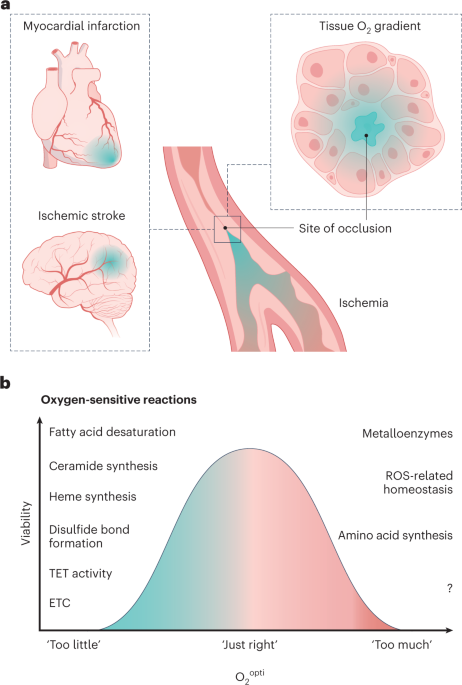
The goldilocks oxygen principle: not too little and not too much
- Select a language for the TTS:
- UK English Female
- UK English Male
- US English Female
- US English Male
- Australian Female
- Australian Male
- Language selected: (auto detect) - EN
Play all audios:
Nature has evolved creative ways to maintain oxygen homeostasis, but what happens when these adaptations are insufficient? Here we discuss biochemical failure points across the oxygen
spectrum from ‘too little’ to ‘too much’ oxygen and their potential contributions to cardiovascular disease. Access through your institution Buy or subscribe This is a preview of
subscription content, access via your institution RELEVANT ARTICLES Open Access articles citing this article. * MECHANISTIC INSIGHTS INTO GUT MICROBE DERIVED SIDEROPHORES AND PHD2
INTERACTIONS WITH IMPLICATIONS FOR HIF-1Α STABILIZATION * Jainabbi Irshad Ahmed Patel * , Jagadeesha Poyya * … Kapaettu Satyamoorthy _Scientific Reports_ Open Access 07 January 2025 ACCESS
OPTIONS Access through your institution Subscribe to this journal Receive 12 digital issues and online access to articles $119.00 per year only $9.92 per issue Learn more Buy this article *
Purchase on SpringerLink * Instant access to full article PDF Buy now Prices may be subject to local taxes which are calculated during checkout ADDITIONAL ACCESS OPTIONS: * Log in * Learn
about institutional subscriptions * Read our FAQs * Contact customer support REFERENCES * Ast, T. & Mootha, V. K. _Nat. Metab._ 1, 858–860 (2019). Article CAS Google Scholar * Park,
T. J. et al. _Science_ 356, 307–311 (2017). Article CAS Google Scholar * Clark, J. M. & Lambertsen, C. J. _Pharmacol. Rev._ 23, 37–133 (1971). CAS Google Scholar * Frank, A. et al.
_Semin. Cardiothorac. Vasc. Anesth._ 16, 123–132 (2012). * Farber, H. W. et al. _J. Heart Lung Transplant_ 37, 948–955 (2018). Article Google Scholar * Stub, D. et al. & AVOID
Investigators. _Circulation_ 131, 2143–2150 (2015). Article CAS Google Scholar * Stanley, W. C., Recchia, F. A. & Lopaschuk, G. D. _Physiol. Rev._ 85, 1093–1129 (2005). Article CAS
Google Scholar * Otsuka, S., Matsumoto, K., Nakajima, M., Tanaka, T. & Ogura, S. _PLoS ONE_ 10, e0146026 (2015). Article Google Scholar * Devlin, C. M. et al. _J. Biol. Chem._ 286,
38069–38078 (2011). Article CAS Google Scholar * Koritzinsky, M. et al. _J. Cell Biol._ 203, 615–627 (2013). Article CAS Google Scholar * Thienpont, B. et al. _Nature_ 537, 63–68
(2016). Article CAS Google Scholar * Bienfait, H. F., Jacobs, J. M. C. & Slater, E. C. _Biochim. Biophys. Acta_ 376, 446–457 (1975). Article CAS Google Scholar * Boehme, D. E.,
Vincent, K. & Brown, O. R. _Nature_ 262, 418–420 (1976). Article CAS Google Scholar * Jain, I. H. et al. _Science_ 352, 54–61 (2016). Article CAS Google Scholar Download references
ACKNOWLEDGEMENTS I.H.J. was supported by US National Institutes of Health (NIH) DP5 DP5OD026398. W.R.F. was supported by NIH R01AG065428. AUTHOR INFORMATION AUTHORS AND AFFILIATIONS *
Gladstone Institutes, San Francisco, CA, USA Will R. Flanigan & Isha H. Jain * UCSF-UC Berkeley Joint PhD Program in Bioengineering, Berkeley, CA, USA Will R. Flanigan * Department of
Biochemistry and Biophysics, University of California, San Francisco, San Francisco, CA, USA Isha H. Jain * Cardiovascular Research Institute, University of California, San Francisco, San
Francisco, CA, USA Isha H. Jain Authors * Will R. Flanigan View author publications You can also search for this author inPubMed Google Scholar * Isha H. Jain View author publications You
can also search for this author inPubMed Google Scholar CORRESPONDING AUTHOR Correspondence to Isha H. Jain. ETHICS DECLARATIONS COMPETING INTERESTS I.H.J. is a consultant for Maze
Therapeutics. W.R.F. declares no competing interests. RIGHTS AND PERMISSIONS Reprints and permissions ABOUT THIS ARTICLE CITE THIS ARTICLE Flanigan, W.R., Jain, I.H. The Goldilocks Oxygen
Principle: not too little and not too much. _Nat Cardiovasc Res_ 1, 1101–1103 (2022). https://doi.org/10.1038/s44161-022-00178-7 Download citation * Published: 12 December 2022 * Issue Date:
December 2022 * DOI: https://doi.org/10.1038/s44161-022-00178-7 SHARE THIS ARTICLE Anyone you share the following link with will be able to read this content: Get shareable link Sorry, a
shareable link is not currently available for this article. Copy to clipboard Provided by the Springer Nature SharedIt content-sharing initiative